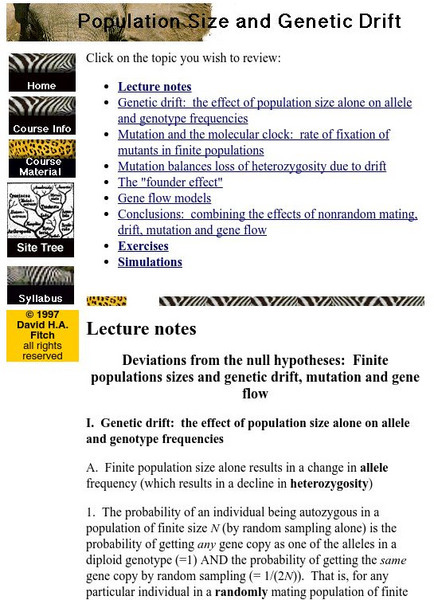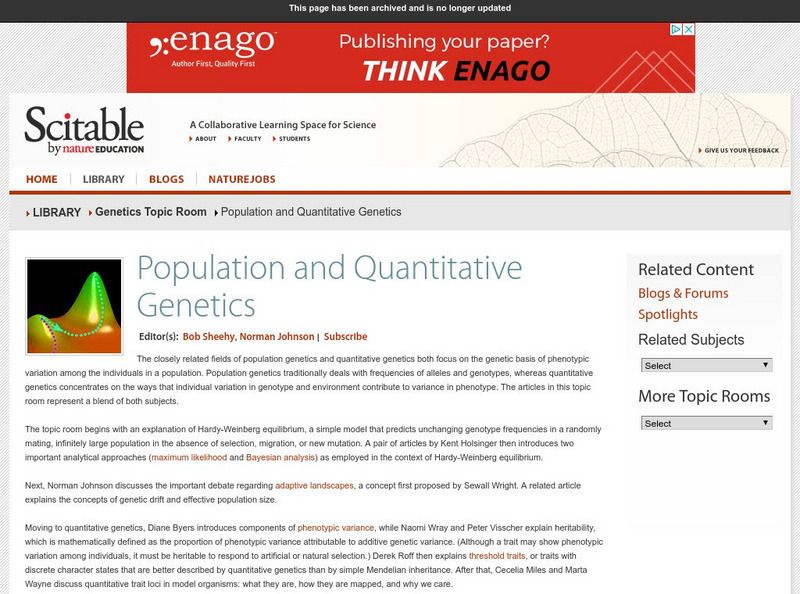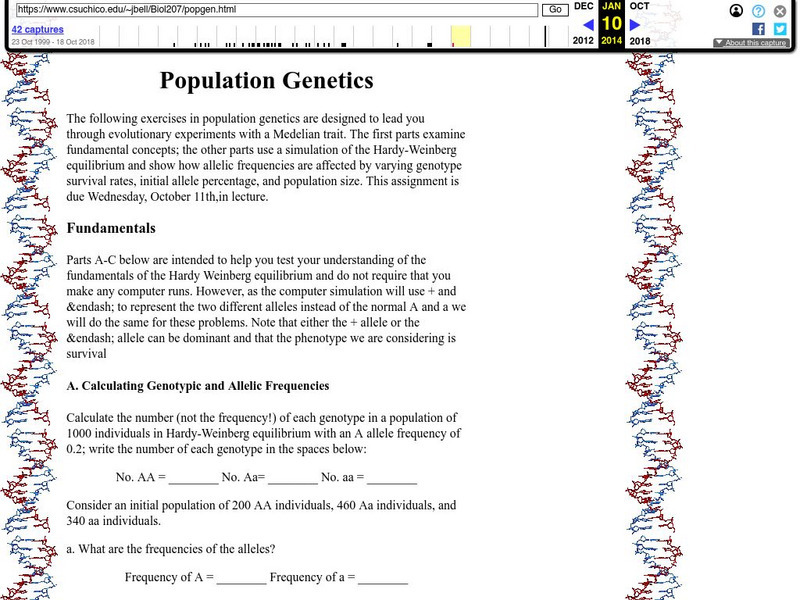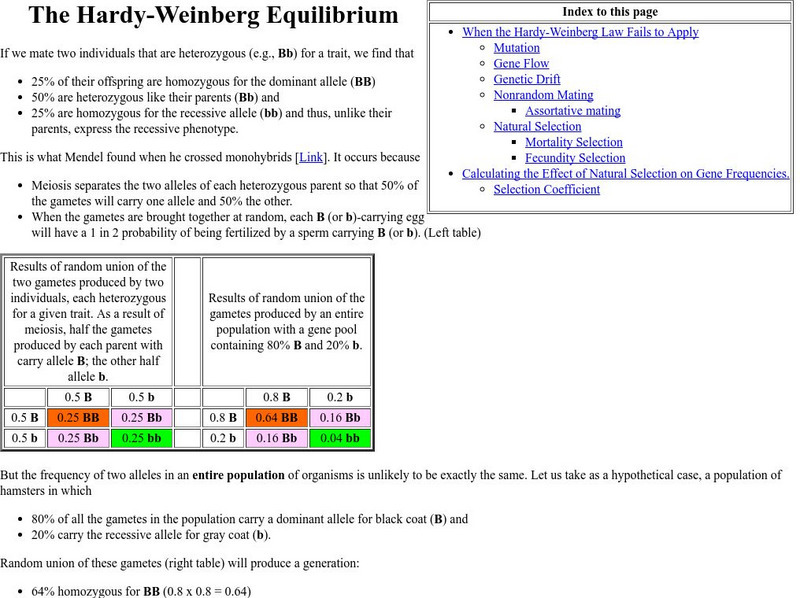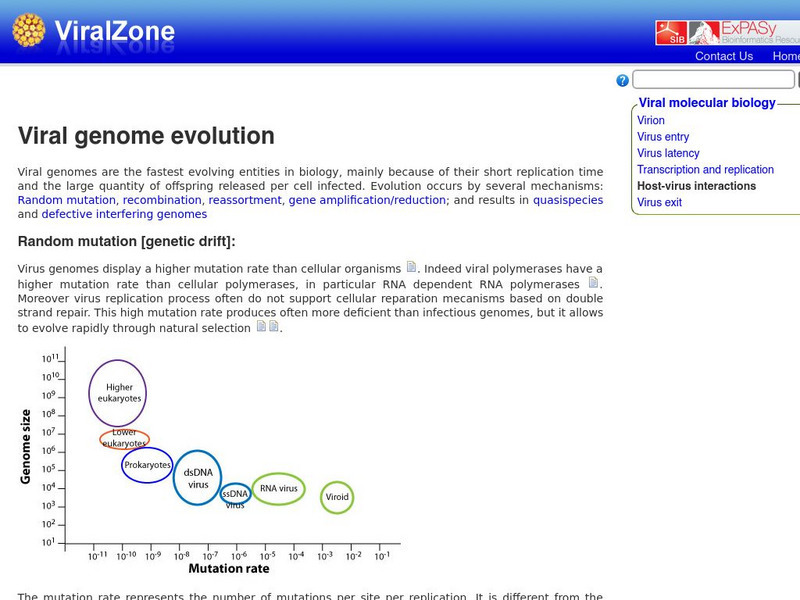New York University
Population Size and Genetic Drift: Lecture Notes
This is a college level lecture on genetic drift, complete with mathmatic formulae, includes special links.
Nature Research
Scitable: Population and Quantitative Genetics
Do you know the difference between population genetics and quantitative genetics? This webpage examines both population genetics which concentrates on frequencies of alleles and genotypes and quantitative genetics which deals with the...
California State University
Csu Chico: Population Genetics
This is a group of Mendelian Genetics exercises that are designed to show the evolution of a trait within a population. The site covers instruction in calculating genotypic and allelic frequencies, determining dominance, the...
Khan Academy
Khan Academy: Genetic Drift
Find out how evolution happens due to chance events. Explore the bottleneck effect and founder effect.
Other
Biology Simulations: Population Genetics
Population genetics is the study of genetic variation in populations. This simulation allows the user to observe the frequencies of two alleles over time.
Khan Academy
Khan Academy: Flu Shift and Drift
Discover how Type B Influenza virus has genetic drift, whereas Type A Influenza virus has genetic drift and shift.
Encyclopedia of Earth
Encyclopedia of Earth: Natural Selection
Scientific article explaining what natural selection is, and how it manifests itself through genetics and from generation to generation. Natural selection is compared to genetic drift, both of which cause evolution to occur. The limits...
Texas Education Agency
Texas Gateway: Mechanisms of Evolution Beyond Natural Selection
Gene pools can change as a result of genetic drift and other mechanisms. This tutorial will investigate how gene pools change and evolve.
Cosmo Learning
Cosmo Learning: Principles of Evolution, Ecology and Behavior
A collection of video lectures introducing beginning biology students to the principles of evolution, ecology, and behavior. The course was taught three times a week for a semester at Yale University. The course discusses concepts of...
BioMan Biology
Bio Man Biology: Angry Aliens: Evolution
Teach aliens about evolution as you play this game, and review your own understanding in the process. Topics covered include evolutionary mechanisms, evidence of evolution, natural selection, reproductive isolation, population genetics,...
CK-12 Foundation
Ck 12: Episd: Forces of Evolution
[Free Registration/Login may be required to access all resource tools.] Students will explore the factors that lead to evolution such as genetic mutation, gene drift and gene flow.
CK-12 Foundation
Ck 12: Biology: Forces of Evolution
[Free Registration/Login may be required to access all resource tools.] Describes three of the four forces of evolution: mutation, gene flow, and genetic drift.
Biology Pages
Kimball's Biology Pages: Hardy Weinberg Equilibrium
Discusses conditions needed for the Hardy-Weinberg Law to hold true and demonstrates calculations involving allelic frequencies to illustrate this principle.
Other
Evolution: The Theory of Natural Selection (Part 1)
These pages are part of a site called Evolution that accompany a textbook by the same name. Mark Ridley is the author. This section has an advanced discussion of determining allele and genotype frequencies using the Hardy-Weinberg ratio.
BioMan Biology
Bio Man Biology: Evolution and Classification Quizzes
A multiple-choice quiz on the mechanisms of evolution.
Other
Viral Zone: Viral Genome Evolution
Viral genomes are the fastest evolving entities in biology, mainly because of their short replication time and the large quantity of offspring released per cell infected. Evolution occurs by several mechanisms: Random mutation,...
Palomar Community College District
Palomar College: Practice Quiz for Gene Flow
This site from Palomar College contains an interactive practice quiz containing four questions on major concepts regarding gene flow. A great learning tool.
American Institute of Biological Sciences
Action Bioscience: Natural Selection: How Evolution Works
An interview with Douglas Futuyma, renowned evolutionary scientist, explaining the theory of natural selection and how it steers toward evolution.
Georgia Department of Education
Ga Virtual Learning: Ap Biology: Evolutionary Biology
Through informational text, interactive activities, animations, and video clips, students investigate evolutionary biology.
Untamed Science
Untamed Science: Biology: Evolution
Discover what evolution is through a case study of a Hawaiian snail species' survival. [7:20]
University of California
University of California Museum of Paleontology: Evolution at Different Scales
Macroevolution and microevolution are defined, along with mutation, migration, genetic drift, and natural selection, which are "established mechanisms of evolutionary change."
Other
Evo Tutor: Evolutionary Processes
EvoTutor is your online resource for interactive simulations of evolutionary processes.
University of California
Understanding Evolution: Mechanisms: The Processes of Evolution
Examine the six major mechanisms of evolution and evolutionary processes.
CK-12 Foundation
Ck 12: Life Science: Features of Populations
[Free Registration/Login may be required to access all resource tools.] A population is a group of organisms of the same species, all living in the same area and interacting with each other. Since they live together in one area, members...
Other popular searches
- Evolution Genetic Drift
- Peanuts Genetic Drift
- Ecology Genetic Drift
- Genetic Drift Activity
- Genetic Drift With Cats
- Genetic Drift Ucla
- Genetic Drift Flying Saucer
- Genetic Drift and Ucla


